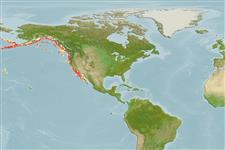Environment: milieu / climate zone / depth range / distribution range
Ecologia
marino batidemersale; distribuzione batimetrica 201 - 1757 m (Ref. 27437). Deep-water; 60°N - 23°N, 179°W - 118°W
Eastern Pacific: Aleutian Islands, Alaska to southern Baja California, Mexico.
Length at first maturity / Size / Peso / Age
Maturity: Lm ? range ? - 27 cm
Max length : 39.0 cm TL maschio/sesso non determinato; (Ref. 27437); Età massima riportata: 45 anni (Ref. 39395)
Short description
Chiavi di identificazione | Morfologia | Morfometria
Spine dorsali (totale) : 15 - 16; Raggi dorsali molli (totale) : 8 - 10; Spine anali: 3; Raggi anali molli: 4 - 6. Head spines very strong - nasal, preocular, supraocular, postocular, tympanic, parietal and nuchal spines present, coronal spines absent (Ref. 27437). Spiny ridge on sub-orbital bone; gill chamber mostly dark; third dorsal spine longest; slight notch on pectoral fin (Ref. 27437). Caudal fin slightly rounded (Ref. 6885). Red rockfish with some black on fins (Ref. 27437).
Adults occur on soft bottom of offshore waters (Ref. 2850). Juveniles occur in midwater (Ref. 2850). Oviparous (Ref. 205). Eggs are spawned in pelagic gelatinous masses (Ref. 59312).
Eschmeyer, W.N., E.S. Herald and H. Hammann, 1983. A field guide to Pacific coast fishes of North America. Boston (MA, USA): Houghton Mifflin Company. xii+336 p. (Ref. 2850)
IUCN Red List Status (Ref. 130435: Version 2024-2)
Threat to humans
Harmless
Human uses
Pesca: commerciale
Strumenti
Special reports
Download XML
Fonti Internet
Estimates based on models
Preferred temperature (Ref.
123201): 3.1 - 6.9, mean 4.1 °C (based on 86 cells).
Phylogenetic diversity index (Ref.
82804): PD
50 = 0.6250 [Uniqueness, from 0.5 = low to 2.0 = high].
Bayesian length-weight: a=0.00912 (0.00407 - 0.02046), b=3.09 (2.88 - 3.30), in cm total length, based on LWR estimates for this (Sub)family-body shape (Ref.
93245).
Trophic level (Ref.
69278): 3.3 ±0.3 se; based on size and trophs of closest relatives
Generation time: 15.7 ( na - na) years. Estimated as median ln(3)/K based on 1
growth studies.
Resilienza (Ref.
120179): Basso, tempo minimo di raddoppiamento della popolazione 4.5 - 14 anni (tm=6; tmax=45 (validate age: 27 yrs)).
Prior r = 0.06, 95% CL = 0.04 - 0.09, Based on 2 full stock assessments.
Fishing Vulnerability (Ref.
59153): High to very high vulnerability (66 of 100).
Nutrients (Ref.
124155): Calcium = 22.2 [8.5, 69.8] mg/100g; Iron = 0.438 [0.195, 1.041] mg/100g; Protein = 16.6 [14.8, 18.4] %; Omega3 = 0.614 [0.245, 1.698] g/100g; Selenium = 21.6 [8.0, 61.7] μg/100g; VitaminA = 25.1 [5.3, 128.1] μg/100g; Zinc = 0.462 [0.243, 0.784] mg/100g (wet weight);
